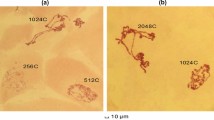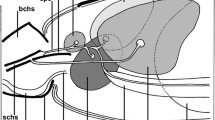Abstract
The patterns of puffing activity have been studied during the late larval and prepupal stages of Drosophila melanogaster. On the major salivary gland autosomes (chromosomes 2 and 3) 108 loci form puffs at some time during these developmental stages. The timing and pattern of activity of 83 of these puffs is found to be strictly dependent upon the age of the animals. Two major peaks in puffing activity occur. The first of these is at the time of puparium formation and the second in 8 hr. old prepupae. Both of these puffing peaks precede a moult by 4 hrs. 30 puffs are active before or at the time of both of these two moults. However, the sequence of appearance and regression of many of this group of puffs is different at the prepupal moult than at the pupal moult. 12 puffs occur only before or at the time of the prepupal moult and 13 puffs only before or at the time of the pupal moult. The functional significance of these periods of puffing activity is discussed and it is concluded that one function of this genetic activity in the salivary glands of metamorphosing Drosophila is the production of substances to be utilised during the histogenesis of the adult tissues.
Similar content being viewed by others
References
Alderson, T,: Culture conditions and mutagenesis in Drosophila melanogaster. Nature (Lond.) 179, 974–975 (1957).
Baudisch, W.: Untersuchungen zur physiologischen Charakterisierung der einzelnen Speicheldrüsenlappen von Acricotopus lucidus. In: Struktur und Funktion des Genetischen Materials, Bd. III, S. 231–233. Erwin-Baur-Gedächtnisvorlesungen (1964).
Becker, H.-J.: Die Puffs der Speicheldrüsenchromosomen von Drosophila melanogaster. I. Beobachtungen zum Verhalten des Puffmasters im Normalstamm und bei zwei Mutanten, giant und lethal-giant-larvae. Chromosoma (Berl.) 10, 654–678 (1959); - II. Die Auslösung der Puffbildung, ihre Spezifität und ihre Beziehung zur Funktion der Ringdrüse. Chromosoma (Berl.) 13, 341–384 (1962).
Beermann, W.: Chromomerenkonstanz und spezifische Modifikationen der Chromosomenstruktur in der Entwicklung und Organdifferenzierung von Chironomus tentans. Chromosoma (Berl.) 5, 139–198 (1952); - Ein Balbiani-Ring als locus einer Speicheldrüsen-Mutation. Chromosoma (Berl.) 12, 1–25 (1961).
Berendes, H. D.: Salivary gland function and chromosomal puffing patterns in Drosophila hydei. Chromosoma (Berl.) 17, 35–77 (1965a); - The induction of changes in chromosomal activity in different polytene types of cell in Drosophila hydei. Develop. Biol. 11, 371–384 (1965b); - Gene activities in the Malphigian tubules of Drosophila hydei at different developmental stages. J. exp. Zool. 162, 209–218 (1966).
Breuer, M. E., and C. Pavan: Behavior of polytene chromosomes of Rhynchosciara angelae at different stages of larval development. Chromosoma (Berl.) 7, 371–386 (1955).
Bridges, C. B., and K. S. Brehme: The mutants of Drosophila melanogaster. Carnegie Inst. of Washington, Publ. 552, 252 p., 1944.
Burdette, W. J., and R. Anderson: Conditioned response of salivary-gland chromosomes of Drosophila melanogaster to ecdysones. Genetics 51, 625–633 (1965).
Clever, U.: Genaktivitäten in den Riesenchromosomen von Chironomus tentans und ihre Beziehungen zur Entwicklung. I. Genaktivierungen durch Ecdyson. Chromosoma (Berl.) 12, 607–675 (1961); - II. Das Verhalten der Puffs während des letzten Larvenstadiums und der Puppenhäutung. Chromosoma (Berl.) 13 385–436 (1962); - IV. Das Verhalten der Puffs in der Larvenhäutung. Chromosoma (Berl.) 14, 651–675 (1963); - Actinomycin and Puromycin: Effect on sequential gene activation by ecdysone. Science 146, 794–795 (1964).
—, and P. Karlson: Induktion von Puff-Veränderungen in den Speicheldrüsenchromosomen von Chironomus tentans durch Ecdyson. Exp. Cell Res. 20, 623–626 (1960).
Edström, J.-E., and W. Beermann: The base composition of nucleic acids in chromosomes, puffs, nucleoli and cytoplasm of Chironomus salivary gland cells. J. Cell Biol. 14, 371–379 (1962).
Fraenkel, G.: The number of moults in the cyclorrhaphous flies (Diptera). Proc. roy. ent. Soc. Lond. (A) 13, 158–160 (1938).
Geiger, H. R., and H. K. Mitchell: Salivary gland function in phenol oxidase production in Drosophila melanogaster. J. Ins. Physiol. 12, 747–754 (1966).
Gross, J. D.: Incorporation of phosphorous-32 into salivary-type chromosomes which exhibit “puffs”. Nature (Lond.) 180, 440 (1957).
Kroeger, H.: Zellphysiologische mechanismen bei der Regulation von Genaktivitäten in den Riesenchromosomen von Chironomus thummi. Chromosoma (Berl.) 15, 36–70 (1964).
—, and M. Lezzi: Regulation of Gene action in Insect Development. Ann. Rev. Entomol. 11, 1–22 (1966).
Laufer, H., and Y. Nakase: Salivary gland secretion and its relation to chromosomal puffing in the Dipteran Chironomus thummi. Proc. nat. Acad. Sci. (Wash.) 53, 511–516 (1965).
Lockshin, L., and C. M. Williams: Programmed cell death. II. Endocrine potentiation of the breakdown of the intersegmental muscles of silkmoths. J. Ins. Physiol. 10, 643–649 (1964); - I. Cytology of degeneration in the intersegmental muscles of the Pernyi silk moth. J. Ins. Physiol. 11, 123–133 (1965a); - V. Cytolytic enzymes in relation to the breakdown of the intersegmental muscles of silk moths. J. Ins. Physiol. 11, 831–844 (1965b).
Misch, D. W.: Localisation of Acid Phosphatase in tissues of metamorphosing fleshfly larvae. J. Histochem. Cytochem. 10, 666 (1962).
Neunes, H. W.: Controlling fluctuations of duration of developmental period in Drosophila. J. Kans. ent. Soc. 35, 269–278 (1962).
Pelling, C.: Ribonucleinsäure-Synthese der Riesenchromosomen. Auto-radiographische Untersuchungen an Chironomus tentans. Chromosoma (Berl.) 15, 71–122 (1964).
Rasch, E. M., and S. Gawlik: Cytolysosomes in tissues of metamorphosing Sciarid larvae. J. Cell. Biol. 23, 123 A (1964).
Ritossa, F.: New Puffs induced by temperature shock, DNP, and salicilate in salivary chromosomes of Drosophila melanogaster. Drosophila Inform. Serv. 37, 122–123 (1963).
Robertson, C. W.: The metamorphosis of Drosophila melanogaster, including an accurately timed account of the principal morphological changes. J. Morph. 59, 351–399 (1936).
Schin, K. S., and U. Clever: Lysosomal and free acid phosphatase in salivary glands of Chironomus tentans. Science 150, 1053–1055 (1965).
Snodgrass, R. E.: Anatomy and metamorphosis of the Apple Maggot, Rhagoletis pomonella Walsh. J. agric. Res. 29, 1–36 (1924).
Whitten, J. M.: The supposed pre-pupa in Cyclorhaphous Diptera. Quart. J. micr. Sci. 98, 241–250 (1957).
Wigglesworth, V. B.: The epicuticle of an insect Rhodnius prolixus (Hemiptera). Proc. roy. Soc. B 134, 163–181 (1947).
Wolfe, L. S.: Further studies of the third instar larval cuticle of Calliphora erythrocephala. Quart. J. micr. Sci. 96, 181–191 (1955).
Author information
Authors and Affiliations
Rights and permissions
About this article
Cite this article
Ashburner, M. Patterns of puffing activity in the salivary gland chromosomes of Drosophila. Chromosoma 21, 398–428 (1967). https://doi.org/10.1007/BF00336950
Received:
Issue Date:
DOI: https://doi.org/10.1007/BF00336950




